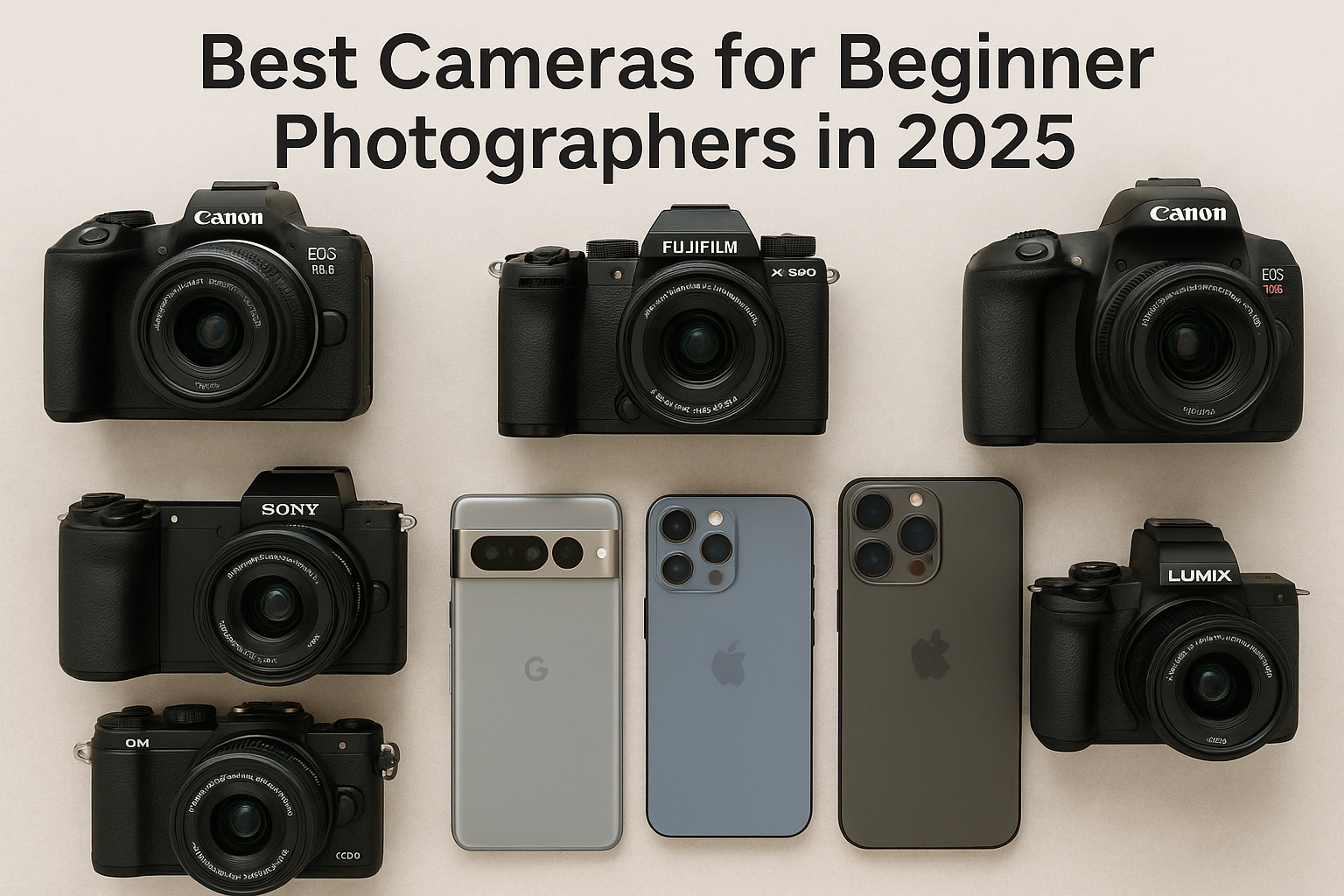Starting photography is easier than ever—but choosing your first camera can still feel overwhelming. With so many models, brands, and features, it’s hard to know what’s worth the investment as a beginner.
This guide highlights the best cameras for beginners in 2025, based on ease of use, performance, price, and long-term value. Whether you want to shoot portraits, landscapes, or content for social media, there’s a camera here for you.
What to Look for in a Beginner Camera
Before jumping to the list, here are key features that matter when you’re just starting out:
Ease of use: Look for a user-friendly menu, auto modes, and a clear interface
Image quality: APS-C or Micro Four Thirds sensors deliver great quality without the price of full-frame
Interchangeable lenses: Offers flexibility to grow with your skills
Video capability: Full HD or 4K is ideal if you want to create video content
Portability: Lightweight cameras are better for travel and everyday shooting
Price: Focus on value—not just specs. You don’t need pro-level gear as a beginner
1. Canon EOS R50
Type: Mirrorless
Sensor: APS-C
Resolution: 24.2 MP
Why it’s great: The Canon EOS R50 is a top choice for beginners in 2025. It combines excellent image quality, 4K video, and a compact build—all in Canon’s growing RF lens ecosystem.
Pros:
Fast and accurate autofocus
Flip-out touchscreen for selfies or vlogging
Lightweight and modern design
Great color science for portraits and people
Ideal for: Portraits, travel, YouTube content, and general use
2. Nikon Z30
Type: Mirrorless
Sensor: APS-C
Resolution: 20.9 MP
Why it’s great: The Nikon Z30 is designed for content creators. It shoots 4K video, has strong autofocus, and supports external mics—making it perfect for vloggers or beginner photographers.
Pros:
Compact and beginner-friendly
Flip screen and clean interface
Reliable image quality
Affordable lens options in the Z-mount lineup
Ideal for: Lifestyle photography, vlogging, and social media creators
3. Sony ZV-E10
Type: Mirrorless
Sensor: APS-C
Resolution: 24.2 MP
Why it’s great: The ZV-E10 is one of Sony’s most popular beginner cameras. It’s part of the same system used by professionals, so you can grow into it over time.
Pros:
Incredible autofocus tracking
Compact and travel-friendly
High-quality 4K video
Connects directly to phones for fast content sharing
Ideal for: Portraits, YouTube, and fast-action subjects
4. Fujifilm X-S20
Type: Mirrorless
Sensor: APS-C
Resolution: 26.1 MP
Why it’s great: If you love aesthetics, vintage design, and color science, Fujifilm is unmatched. The X-S20 offers advanced features in a compact body, with beautiful straight-out-of-camera images.
Pros:
Film simulations for instant creative looks
In-body stabilization (IBIS) for smooth photos and video
Strong battery life
Touchscreen and intuitive controls
Ideal for: Street, lifestyle, and creative everyday photography
5. Canon EOS Rebel T8i (850D)
Type: DSLR
Sensor: APS-C
Resolution: 24.1 MP
Why it’s great: If you prefer a traditional DSLR, the T8i is a reliable and affordable option. While DSLR systems are being phased out, they still offer great learning tools and second-hand value.
Pros:
Bright optical viewfinder
Articulating screen
Good battery life
Access to affordable used lenses
Ideal for: Learning manual controls, portraits, and outdoor photography
6. OM System OM-5 (formerly Olympus)
Type: Mirrorless
Sensor: Micro Four Thirds
Resolution: 20 MP
Why it’s great: Small but mighty, the OM-5 is great for travel and creative photography. The Micro Four Thirds format means more compact lenses and faster autofocus.
Pros:
Weather-sealed and durable
Great in-body stabilization
Live ND filter simulation
Compact lens system
Ideal for: Travel, landscapes, and handheld video
7. Panasonic Lumix G100
Type: Mirrorless
Sensor: Micro Four Thirds
Resolution: 20.3 MP
Why it’s great: Designed with vloggers and content creators in mind, the Lumix G100 offers crystal-clear audio and 4K video, along with a solid photography toolset.
Pros:
Excellent microphone system
Good ergonomics for small hands
Lightweight and compact
USB charging
Ideal for: YouTube, social media, and beginner video creators
Bonus: Best Smartphone Alternative – Google Pixel 8 Pro or iPhone 15 Pro
If you’re not ready to buy a dedicated camera yet, these smartphones offer excellent image quality with:
Manual camera controls
RAW shooting support
Incredible low-light performance
Built-in editing tools
They’re great for learning composition and light without the bulk of a camera system.
Tips for Choosing the Right Beginner Camera
Know your goals—Do you want to shoot portraits, video, or travel content?
Test the grip and menu—Visit a camera store and see how it feels in your hands
Check lens availability—Make sure you can expand your setup in the future
Stick to your budget—Spend more time learning and less money on gear
You Don’t Need the Best—Just the Right Camera for You
In 2025, there are more beginner-friendly camera options than ever. The “best” camera is the one that fits your budget, feels good to use, and encourages you to shoot regularly.
Start with something reliable, learn the basics, and let your creativity do the rest. You’ll grow faster than you think—no matter which camera you choose.
